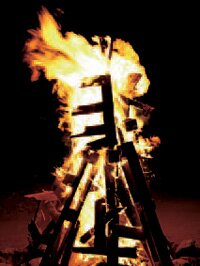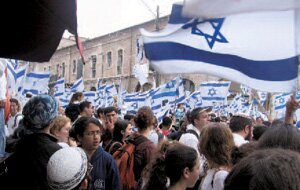| Lag B'Omer and Yom Yerushalayim |

|

|
|
Lag B'Omer The period of the counting of the Omer, the forty-nine days between the second day of Pesach and Shavuot, is a mournful period. It directly links the freedom from bondage in Egypt with our ultimate redemption and the receipt of the Torah.
The omer is a specified measure of grain required for offering. While the offering is no longer required since the destruction of the Temple, many Jews still observe the custom. Rituals are followed and special prayers are recited each day during the omer period, but modern technology now provides a host of creative ‘omer counters' relying on the latest in technology: SMS messages. Despite the innovation, weddings and other celebrations, as traditionally observed, are still forbidden and religious Jews will not have their hair cut, a custom associated with mourning. On the thirty-third day of the Omer, there is however a day to celebrate, Lag B'Omer. It is one of the few days of the period that weddings are permitted. The mourning period is also suspended to allow modern Jews to participate in festivities to mark Yom Ha'atzmaut. Lag B'Omer commemerates a historic event in Jewish history. In the time of Rabbi Akiba (50-137 CE) a plague took the lives of over ten thousand of his students. The plague ended on the thirty-third day of the Omer. The holiday, in part, commemorates the students and celebrates the end of the plague, the day was set aside. Additionally, in 66 CE, the successful revolt against Rome also began on that sameday, led by Bar Kochba. The significance of Lag B'Omer however goes beyond its historic foundations and also ties in a mystical and spiritual association with the day. It is recorded as the day in which Simeon Bar Yochai died. Bar Yochai was the mystic credited with authorship of the Zohar. Jews visit his grave in Meron to mourn his death on this day as well. Many Jews hold weddings on this day and numerous traditional Jews select this day to hold Upsheren or fi rst hair cut of three-year old boys. For secular and religious Jews alike, it is a day of outings in nature, joyous picnics and often marked by giant bonfires. Yom Yerushalayim
Yom Yerushalayim, or Jerusalem Day, is the most modern of all the holidays on the Hebrew calendar. It is celebrated on the 28th day of Iyar, one week before the eve of Shavuot. Although Jerusalem has always been the spiritual capital of Judaism and in the hearts of Jews everywhere, the holiday celebrates the Israeli army's victory in the ancient, eastern part of the city on the third day of the Six-Day War in 1967 when a unifi cation of the two sections of the city took place, ending 19 years of separation. While still less popular than Yom Ha'aztmaut, Jews worldwide are increasingly embracing this holiday and developing Diaspora traditions to mark the event. Jews worldwide continue to chant age-old liturgy and quote poetry that make constant reference to Jerusalem as central to our people. Daily we pray towards Jerusalem and all conclude our Seders with the words “next year in Jerusalem.†In Israel and in the Diaspora festivals of music, dance and theater bring Jews together to mark the day. Educators use this time to increase knowledge on the specifics of the city including the history and the role it has played in our collective conscious. (Issue May 2009)
|



















